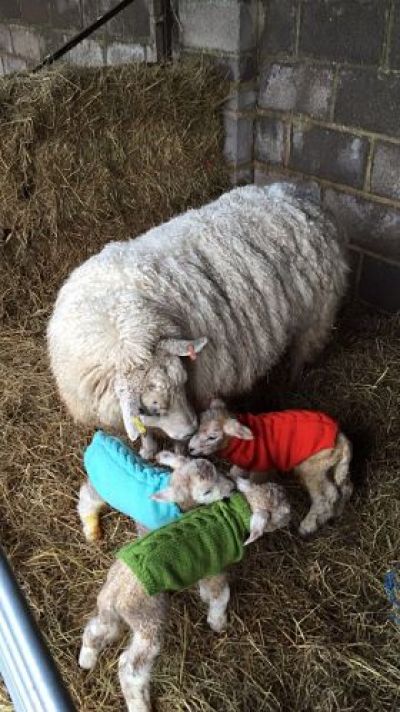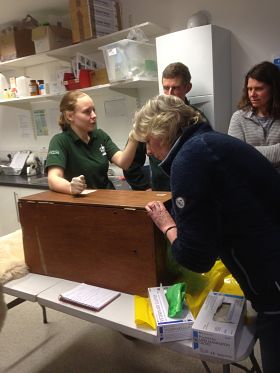
Posted By:
Shepton Vets Smallholders Club holds practical workshops throughout the year for Smallholders across Somerset. The latest meetings were evening Lambing Workshops which were run in January and March for clients preparing for lambing season. This is always a very popular event, as the workshops provide knowledge and skills, giving the smallholders the confidence for a successful lambing season.
The workshop was divided up into 3 different areas: Pre-lambing preparation, Lambing and Post Lambing.
We discussed the importance of being organised before the lambing period begins. There are lots of different areas that, if sorted before lambing commences, will make life a lot easier and result in more live and stronger lambs.
Condition scoring sheep is very important during the whole production cycle, not just around lambing. We condition score sheep by palpating their lumbar vertebra, feeling for how much fleshy covering there is over their dorsal and transverse spinal processes. We score them on a scale of 1-5. Aiming for a condition score of around 3, for the majority of the year. We recommended that a good time to condition score your sheep would be 6-8 weeks before putting the ram in and again, 6-8 weeks before lambing is due to commence. By assessing your sheep around this time it means you have sufficient time to make changes to their diet if necessary.
Vaccinating the ewes before the lambs are born is also a good idea. Because of the structure of a sheep placenta, the lambs, unlike humans, do not receive any antibody protection whilst in the uterus. This means that they can be very vulnerable to infection once born. Lambs receive all their antibody protection for the first couple of months, via the colostrum from their Mum. Colostrum is the first secretion from the mammary gland. It is high in energy and rich in antibodies. By vaccinating the ewes several weeks before lambing, with a vaccine that protects against several clostridial diseases. It means that the ewes will secrete these antibodies to those diseases in the colostrum, so the lambs will have immunity for the first couple of weeks, until they are vaccinated them selves when they are older.
Making sure you have all the equipment you need ready, before lambing commencing means you should be prepared for all eventualities. Some equipment that we thought would be useful to have included: lambing ropes, obstetric lubricant, strong iodine for dressing the navels, towels and gloves to name but a few.
During the workshop we also covered what you would expect to see during a normal lambing. Dividing lambing up into three stages: 1st stage of labour where the ewe becoming restless as her birth cannel prepares for the lamb, 2nd stage of labour is when the lamb is born and third stage of labour is when the foetal membranes are passed.
We discussed how to manage several different cases of dystocia an “obstructed labour”. The normal presentation of a lamb is to come out front feet first, in a diving position. During the workshop we chatted through how to deal with serval common malpresentation including: A lamb with its head back, leg(s) back, breech and multiple lambs coming at the same time. All those attending had the chance to practice there news skills on our lambing simulator. A lamb cadaver was placed in lots of awkward positions, which they then had to practice correcting to lamb the simulator.

Post lambing, it was stressed the importance of ensure all lambs born receive sufficient colostrum, for reasons mentioned above. The colostrum is so important to new born lambs; it is rich in energy, which is important for a lamb to receive as soon as possible after birth, as lambs have limited internal energy reserves. They are born wet so end up using lots of this energy very quickly to keep warm. The lambs also need the colostrum to provide them with antibodies to protect them from infection during the first couple of weeks of life, until they start to develop their own.
We also stress the need to make sure that all lambs have their navels dipped with strong iodine as soon a possible after birth. This is to help minimise the risk of infection tracking up the navel into the lambs body. We recommended re-treating the navel again with strong iodine, a few hours later, as often very good ewes lick clean their lambs also cleaning off lots of the iodine!
The smallholders practiced docking our cadaver lamb’s tail, as well as castrating, using the elastrator bands. It was an opportunity to discuss several key things to remember when docking tails and castrating lambs. The most common method used, is the elastrator bands. This must be done within the first week of life. The tails must be kept long enough to cover the genitalia of the lambs when grown. When castrating, both testicles must be within the scrotum, making sure the band is not placed to high to include the teats, or the urethra.
At the end of the workshop all our smallholders went home with a goodie bag, full of useful items ready for the lambing season ahead. Items included: Lambing ropes, Lubricant, colostrum powders and all the notes from the evening. We hope that our smallholders now feel confident to deal with their own lambing season, but we are always there to help, whether they want us to come and give them a hand or some tip and tricks over the phone. We are looking forward to seeing all their baby lamb photos this year!
As our feline friends get older there are a few conditions...
Another winter discussion group season is now behind...
We used a client’s new Morris Remote Control...
©2024 Shepton Veterinary Group Ltd., All rights reserved.
Privacy Policy • Terms & Conditions • Cookie Policy